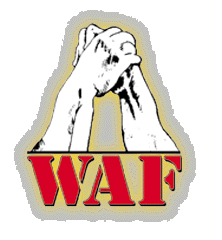Section 2 – Equipment
Specifications
2.1 Table
Sit down: 28” from floor to top of table
Stand-up:40” from floor to top of table
All other specifications are identical for both sit down
and stand-up table tops
2.2. Table Top
36”across and 26”deep.
2.3. Elbow Pads
7” x 7” square shape. 2” thick, made of heavy high
quality foam material, covered with vinyl/rexin type cover. The foam can be
attached to a 1/8” metal sheet, 7” x 7” with two threaded bolts ¼” diameter x 1
¾” long, welded to the bottom to be able to attach your elbow pads to the table
top. A line, either painted, upholstered or taped from hand grip to hand grip
to establish center of the table will always be used at WAF tournaments.
2.4. Touch Pads
10” long x 4”high. Made of good quality touch pad
2.5. Placement
Elbow
pads should beset 2” from their respective edge. They should overlap each other
by ½ to the Right of center for a right arm table and overlap each other by ½
to the left of center for a left arm table.
2.6. Touch Pads
Should be on an
angle,5”out from the inside corner of the elbow pad to the inside corner of the pad
and ½” from its respective edge measured
to the outside corner of the pad. Running at an angle towards the hand peg it should
measure 2 ¾” from the hand peg to the outside corner of the touch pad. If it’s
for a right arm table, these measurements should be made on the left side of
the elbow pad and reversed if it’s a left arm table.
2.7. Hand Pegs
Should be placed
midway at 13”on each edge of the table, 1” in from the edge. The peg itself should
be 1” in diameter and 6”high from the table top.
2.8. Table Frame
Dimensions for the
inside frame are: 28” minimum – inside leg 18” minimum from leg to leg and that
we always have 4 legs.
2.9. Seats
They
should be 18” square and 18” from the floor surface to seat top surface. The
front edge should be exactly in line with the table edge. The seat and table should
be secured to a platform or floor
2.10. Material
The
best material to use is square tubing although tubular steel, flatiron or angle
iron maybe used, but not more than 2” in diameters or width. The table top and
seat top are normally made of¾” thick plywood. The table top and seat may have
a thin sheet of foam, covered with vinyl/rexin type material to add a comfortable
finished look. No plexi-glass or reflective tape is to be used on the table top
or seats
2.11. Chalk Stand
A stand suitable for chalk / rosin
or stickum should be placed on either side of the table but at a suitable
distance away so as not to bother referees or minor officials with the dust floating
in the air or with competitors preparing to match.
2.12. Staging
If
raising staging is used, hosts are responsible for supplying or installing protective
railing around the perimeter, to prevent competitors from accidentally falling off.
Stages should also be planned with the intent to keep non-participants away
from the competition table and draw sheet table.
2.13. Riser Platforms
Riser
platforms can be used by competitors who have a height disadvantage. Riser
platforms can be used in combination with platform shoes or multiple platforms,
to raise the competitor, to at least bring their waist to table top.
Competitors can use a personal riser with prior permission of the Head Referee before
the start of contest. For consistency and ease of handling reasons, riser
platforms will be built of ½” thick plywood, 4” high x 36” widex 32” deep. They
will be notched at the top part, as to fit the table legs on each their respective
side, to prevent them from slipping out during competition. Approximately 3”
from the top, the notches, on either side will be located. A hand slot will be
cut in the center to facilitate there moval and installation of the riser
platform.
2.14. Straps
When used, they will
be of a standard 1” style with a plastic or metal buckle and not of Velcro. The
straps used by WAF will be 1”wide (2002).
2.15 Uniforms
2.15.1. All participants, including athletes and officials, must be
familiar with and adhere to the WAF
costume code. Each country must be identifiable and each competitor indentify able
to its country.
2.15.2. Only short sleeve
or sleeveless shirts and sport pants (no jeans) allowed during competition.
Very limited advertising is allowed on shirts only.
2.15.3. Shoes are required as part of the uniform and
to compete in the tournament
2.15.4. No competitor may compete out of uniform; no
competitor may receive their award out of uniform. If a competitor comes on
stage to compete out of uniform they will forfeit that bout. A country without uniform
may request in writing.




0 comments:
Post a Comment